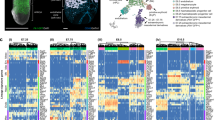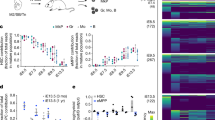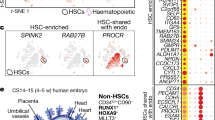Abstract
It has been proposed that haematopoietic and endothelial cells share a common progenitor, termed the haemangioblast. This idea was initially conceived as a result of the observation that these two cell types develop in close proximity to each other within the embryo1,2. Support for this hypothesis was provided by studies on single-cell-derived colonies that can produce both haematopoietic and endothelial cells in vitro3,4,5,6,7. Although these data point towards the existence of a common progenitor for these two lineages, the presence of a bipotential progenitor cell has yet to be demonstrated in vivo. Through the construction of single-cell-resolution fate maps of the zebrafish late blastula and gastrula, we demonstrate that individual cells can give rise to both haematopoietic and endothelial cells. These bipotential progenitors arise along the entire extent of the ventral mesoderm and contribute solely to haematopoietic and endothelial cells. We also find that only a subset of haematopoietic and endothelial cells arise from haemangioblasts. The endothelial descendants of the haemangioblasts all clustered in a specific region of the axial vessels regardless of the location of their progenitors. Our results provide in vivo evidence supporting the existence of the haemangioblast and reveal distinct features of this cell population.
This is a preview of subscription content, access via your institution
Access options
Subscribe to this journal
Receive 51 print issues and online access
$199.00 per year
only $3.90 per issue
Buy this article
- Purchase on Springer Link
- Instant access to full article PDF
Prices may be subject to local taxes which are calculated during checkout



Similar content being viewed by others
References
Sabin, F. Preliminary note on the differentiation of angioblasts and the method by which they produce blood-vessels, blood-plasma and red blood-cells as seen in the living chick. Anat. Rec. 13, 199–204 (1917)
Murray, P. D. F. The development in vitro of the blood of the early chick embryo. Proc. R. Soc. Lond. B 11, 497–521 (1932)
Choi, K., Kennedy, M., Kazarov, A., Papadimitriou, J. C. & Keller, G. A common precursor for hematopoietic and endothelial cells. Development 125, 725–732 (1998)
Schuh, A. C., Faloon, P., Hu, Q. L., Bhimani, M. & Choi, K. In vitro hematopoietic and endothelial potential of flk-1-/- embryonic stem cells and embryos. Proc. Natl Acad. Sci. USA 96, 2159–2164 (1999)
Fehling, H. J. et al. Tracking mesoderm induction and its specification to the hemangioblast during embryonic stem cell differentiation. Development 130, 4217–4227 (2003)
Huber, T. L., Kouskoff, V., Fehling, H. J., Palis, J. & Keller, G. Haemangioblast commitment is initiated in the primitive streak of the mouse embryo. Nature 432, 625–630 (2004)
D'Souza, S. L., Elefanty, A. G. & Keller, G. SCL/Tal-1 is essential for hematopoietic commitment of the hemangioblast but not for its development. Blood 105, 3862–3870 (2005)
Kimmel, C. B., Warga, R. M. & Schilling, T. F. Origin and organization of the zebrafish fate map. Development 108, 581–594 (1990)
Warga, R. M. & Nusslein-Volhard, C. Origin and development of the zebrafish endoderm. Development 126, 827–838 (1999)
Kinder, S. J. et al. The orderly allocation of mesodermal cells to the extraembryonic structures and the anteroposterior axis during gastrulation of the mouse embryo. Development 126, 4691–4701 (1999)
Parker, L. H., Zon, L. & Stainier, D. Y. R. in Methods in Cell Biology, The Zebrafish (eds Detrich, W., Zon, L. & Westerfield, M.) 313–336 (Academic, San Diego, California, 1999)
Gering, M. & Patient, R. Hedgehog signaling is required for adult blood stem cell formation in zebrafish embryos. Dev. Cell 8, 389–400 (2005)
Westerfield, M. The Zebrafish Book (Univ. of Oregon Press, Eugene, Oregon, 1993)
Jin, S. W., Beis, D., Mitchell, T., Chen, J. N. & Stainier, D. Y. Cellular and molecular analyses of vascular tube and lumen formation in zebrafish. Development 132, 5199–5209 (2005)
Traver, D. et al. Transplantation and in vivo imaging of multilineage engraftment in zebrafish bloodless mutants. Nature Immunol. 4, 1238–1246 (2003)
Horne-Badovinac, S., Rebagliati, M. & Stainier, D. Y. A cellular framework for gut-looping morphogenesis in zebrafish. Science 302, 662–665 (2003)
Kozlowski, D. J., Murakami, T., Ho, R. K. & Weinberg, E. S. Regional cell movement and tissue patterning in the zebrafish embryo revealed by fate mapping with caged fluorescein. Biochem. Cell Biol. 75, 551–562 (1997)
Keegan, B. R., Meyer, D. & Yelon, D. Organization of cardiac chamber progenitors in the zebrafish blastula. Development 131, 3081–3091 (2004)
Acknowledgements
We thank members of the Stainier and Martin laboratories for discussion and critical reading of the manuscript; D. Traver and L. Zon for the Tg(gata1:DsRed) line; and D. Yelon for advice with caged fluorescein. This study was supported by an NSF Pre-doctoral Fellowship (K.M.V.); an American Heart Association Post-doctoral Fellowship (S.-W.J.); the Packard foundation (D.Y.R.S.); and the National Institutes of Health (G.R.M. and D.Y.R.S.).
Author information
Authors and Affiliations
Corresponding author
Ethics declarations
Competing interests
Reprints and permissions information is available at www.nature.com/reprints. The authors declare no competing financial interests.
Rights and permissions
About this article
Cite this article
Vogeli, K., Jin, SW., Martin, G. et al. A common progenitor for haematopoietic and endothelial lineages in the zebrafish gastrula. Nature 443, 337–339 (2006). https://doi.org/10.1038/nature05045
Received:
Accepted:
Issue Date:
DOI: https://doi.org/10.1038/nature05045
This article is cited by
-
Zebrafish: a convenient tool for myelopoiesis research
Cell Regeneration (2023)
-
Hand2 delineates mesothelium progenitors and is reactivated in mesothelioma
Nature Communications (2022)
-
Light-sheet fluorescence imaging charts the gastrula origin of vascular endothelial cells in early zebrafish embryos
Cell Discovery (2020)
-
Transforming growth factor-β1 regulates the nascent hematopoietic stem cell niche by promoting gluconeogenesis
Leukemia (2018)
-
Blood on the tracks: hematopoietic stem cell-endothelial cell interactions in homing and engraftment
Journal of Molecular Medicine (2017)
Comments
By submitting a comment you agree to abide by our Terms and Community Guidelines. If you find something abusive or that does not comply with our terms or guidelines please flag it as inappropriate.



